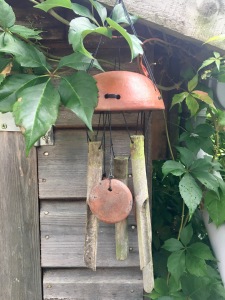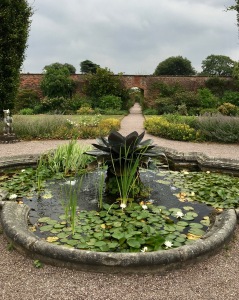When developing a garden I imagine that for most of us the first consideration is the visual: colour schemes, shapes and forms, composition. We might also think about choosing plants which provide fragrance that we can enjoy with our morning coffee or evening glass of wine, as I discussed in a previous blog. But how many of us consider the role of sound in the way we experience gardens and green spaces, never mind deliberately incorporate elements which contribute to and enhance the soundscape?
I don’t think I fully appreciated the incredible array of sounds which envelope you in a garden, or how they contribute to the richness of the experience, until I started trying my hand at meditation. I had been struggling with anxiety for an extended period and to a degree which was impinging on my quality and enjoyment of life, and after reaching a bit of a crisis point felt it was time to make an intervention. I began to learn about mindfulness: experiencing life in the moment, accepting feelings and situations as they are, and recognising that both the good and the bad are temporary states. Following an excellent book, I started practising a series of short meditations which focussed primarily on breathing and physical sensations, but also on other aspects including sounds. Now, you can be pretty much anywhere and focus in on the sounds around you, but there’s no escaping that doing so in a garden brings a particular sense of calm.
The rustling of the wind through the leaves of a tree; the twittering of small birds, the machine-gun squawk of Magpies and the low cooing of Woodpigeons; in summer the buzzing of bees as they forage amongst the flowers for nectar; and the drumming of rain on wide-leaved plants, all creating that living soundtrack. Even the noises of the city beyond the garden: growling car engines; the clank and screech of the trains pulling out of the station; and the sirens of emergency vehicles from the nearby fire station and hospital, contribute to the orchestra of sounds. Focussing in on these different elements helps to ground you in the present moment, which can be particularly helpful if your errant mind is wandering back to some previous point of irritation, or zooming forward to a potential catastrophe which often never comes.
Rain on broad leaves:

Sounds will exist in a garden and its surrounding environment regardless of whether features have been deliberately included to awaken this sense or not, but there are some elements which can be planned to promote aural stimulation. The most obvious is the inclusion of an artefact which is designed to generate a noise you find appealing. In my own garden we have had a wind chime hanging from the shed roof for many years. It is made from bamboo and generates a very pleasing clonking sound in the breeze. As well as making a welcome contribution to the garden soundscape, it triggers fond memories of a period of travel round South-East Asia where bamboo wind chimes are found quite commonly in beach bars and the like. Thoughts drift to drinking exceptionally strong beer while leaning on one of those wedge-shaped cushions, and listening to the sound of the sea – before I grew up (sort of) and got a pension and mortgage *sigh*.
Wind Chime:

Water features are another element that can bring sound to a garden whether that is a fountain, an inclined rill trickling water into a pool, or even a pond rippling in the wind or receiving the steady drip of rain. Fountains of course can take many forms from high velocity geysers of water to gently dribbling rivulets so it depends on what sort of effect one is trying to achieve, and indeed the space available. I like the sound created by the Japanese rocking fountain “Shishi Odoshi” which was apparently first used as a deer scarer – featured to great effect in the ‘Death of O’Ren Ishii’ scene in Kill Bill Vol.1 for those of you who are Tarantino fans! Made from bamboo it again features a lovely clonking sound as one bamboo pipe trickles water into another until it tips up, empties, and tips back. Personally, much as I would love to incorporate a small a water feature in our garden, that ambition has been put on hold since the arrival of number one son.
Fountain at Arley Hall:
Planting itself can also be source of sound. In my small enclosed and sheltered garden the sound tends to come from elevated planting such as our mature ornamental Cherry Prunus ‘Spire’ with the breeze rustling through the leaves. Similarly our neighbour’s Fan Palm (possibly Chamaerops humilis) makes a fantastic buzzing sound as the palm spikes vibrate against each other in the wind. In more open gardens the use of grasses which bend and sway in the wind can also provide a source of sound, such as the Giant Quaking Grass Briza maxima or Bamboos such as Phyllostachys sp.
Trees:
I find gardening a naturally mindful activity and it plays a significant part in maintaining my equilibrium in amongst the various demands of life. I know I am not alone in this from the many blogs and social media posts I have seen from others who find gardening therapeutic as well as enjoyable and rewarding in its own right. It is easy to become absorbed in whatever horticultural task you have set about, but it is important to stop from time to time and engage the senses in the sights, smells and sounds emerging from that little oasis.
Recommend Reading
If you would like to read more about mindfulness I would recommend the following book:
Mindfulness: A practical guide to finding peace in a frantic world by Mark Williams and Dr Danny Penman (2011)
This is a great article. Among the smells and sights of a garden, sound is an important part of the atmosphere, as well. Thanks for sharing.
LikeLike
Thanks. Glad you liked it!
LikeLike